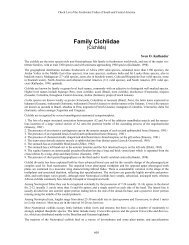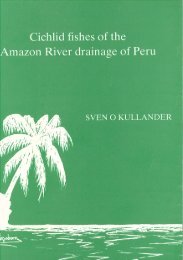Open Access PDF - Sven Kullander
Open Access PDF - Sven Kullander
Open Access PDF - Sven Kullander
You also want an ePaper? Increase the reach of your titles
YUMPU automatically turns print PDFs into web optimized ePapers that Google loves.
as tubed scales, may thus be influenced by misalignment<br />
or small size. The smallest specimens<br />
recorded with a continuous lateral line are 45.5<br />
(C. temensis), 50.0 (C. ocellaris), and 62.1 mm SL<br />
(C. jariina).<br />
The total number of dorsal fin spines and rays<br />
(Table 6) is modally 32 in all species except<br />
C. jariina with 31. All species have modal count<br />
XV.17 except C. jariina (XV.16), C. vazzoleri (XV.16),<br />
and C. nigromaculata (XVI.16). Also C. pinima and<br />
C. thyrorus have a high frequency of XV.16. The<br />
frequency distribution of anal fin rays (Table 7)<br />
shows little variation, with 11 rays modal for the<br />
genus and all species. The pectoral fin count<br />
(Table 8) varies between 14 and 15, with occasional<br />
13 or 16. Higher numbers occur principally<br />
in the more elongate species, viz. C. pinima,<br />
C. vazzoleri, C. temensis, and C. intermedia, but also<br />
in C. jariina.<br />
Vertebral counts (Table 9) separate species<br />
into two groups, those with modally 36 vertebrae<br />
(18+18 or 19+17), and those with 35 (almost exclusively<br />
18+17), and C. jariina exceptional with<br />
34 vertebrae.<br />
Gill rakers (Table 10) were counted as distinguishable<br />
units, and since the anteriormost gill<br />
rakers become flat and contiguous in large specimens,<br />
the variation in counts to some extent reflects<br />
the length of the specimens in the sample.<br />
Our only conclusion is that gill-raker counts are<br />
generally between 13 and 15, with juveniles having<br />
up to 20. The higher numbers in C. temensis<br />
may reflect a later transformation as well as a<br />
higher average.<br />
Morphometric information is available from<br />
304 specimens 29.3-414 mm SL (Tables 12-26). In<br />
a principal component analysis of morphometric<br />
distance data (Fig. 3, Table 11), there are only<br />
traces of allometry, except in the orbital diameter,<br />
and shearing factor 2 did not alter the scatter.<br />
Species with complete or abbreviated juvenile<br />
lateral band tend to cluster apart on factor 2, but<br />
show considerable overlap. Variation mainly<br />
refers to body depth, which tends to be less in<br />
several species with complete juvenile lateral band<br />
(particularly C. intermedia, C. jariina, C. pinima,<br />
C. temensis, and C. vazzoleri) compared to species<br />
with abbreviated juvenile band (C. kelberi, C. monoculus,<br />
C. ocellaris, C. orinocensis, C. pleiozona, and<br />
probably C. nigromaculata), and caudal peduncle<br />
length, which tends to be correspondingly longer.<br />
Cichla piquiti and C. thyrorus cluster in the<br />
midrange, and C. mirianae and C. melaniae span<br />
Ichthyol. Explor. Freshwaters, Vol. 17, No. 4<br />
387<br />
both major clusters. In comparing similar species,<br />
there are no trenchant morphometric differences.<br />
Proportional measurements for each species are<br />
summarized in Tables 12-26. Whereas some species<br />
of there is variation between extremes the<br />
overlap prevents use of proportional characters<br />
to identify specimens to species. Figure 4 illustrates<br />
the gradual variation in body depth expressed<br />
as per cent of SL, with species with abbreviated<br />
juvenile lateral band having body<br />
depths up to 31.5-34.6 % SL, the more deep-bodied<br />
species of species with complete lateral band<br />
up to 30.7-32.8 % SL, and the slender species<br />
(particularly C. intermedia, C. jariina, C. pinima,<br />
C. temensis, and C. vazzoleri) maximum body<br />
depths 27.3-30.7 % SL, with C. temensis at the<br />
extreme with a variation 21.3-27.3 % SL (Tables<br />
12-26). A comparison including only large specimens<br />
(> 199 mm SL; graph not shown) produces<br />
the same general graphic pattern, but with less<br />
confidence and excluding C. intermedia of which<br />
no large specimens were available.<br />
In the morphologically diverse South American<br />
cichlid genus Crenicichla body depth varies<br />
from 12.5 % SL in small, elongate species, to 32.4 %<br />
(N = 590) (pers. obs.). In genera representing a<br />
“normal” South American cichlid body plan, and<br />
with very little interspecific differences, the<br />
variation is 37-45 % of SL (N = 475) in Aequidens,<br />
and 34-45 % SL (N = 322) in Satanoperca (pers. obs.).<br />
The magnitude of variation in Cichla is thus comparable<br />
with Aequidens and Satanoperca albeit<br />
values are contained within the upper range of<br />
Crenicichla.<br />
Juvenile colour pattern. Comparatively little is<br />
known about larval and juvenile cichlid colour<br />
pattern ontogeny, although it is potentially phylogenetically<br />
informative. Cichla and Crenicichla<br />
are the only genera of South American cichlids<br />
with a juvenile colour pattern including a horizontal<br />
midlateral stripe (Figs. 37, 49, 50-51, 55, 60,<br />
64-66, 72, 74, 76-77, 81-85, 88, 90-91), and some<br />
species of Cichla are unique in the possession of<br />
an abbreviated lateral band extending only between<br />
the posterior lateral blotch and the caudal<br />
fin base (Figs. 5, 10-13, 24, 28-30).<br />
Species with a complete lateral band include<br />
C. intermedia, C. jariina, C. melaniae, C. mirianae,<br />
C. pinima, C. piquiti, C. temensis, C. thyrorus, and<br />
C. vazzoleri. In these species, the lateral band remains<br />
to at least 100-150 mm SL, in C. mirianae<br />
and C. intermedia it remains as an irregular stripe




